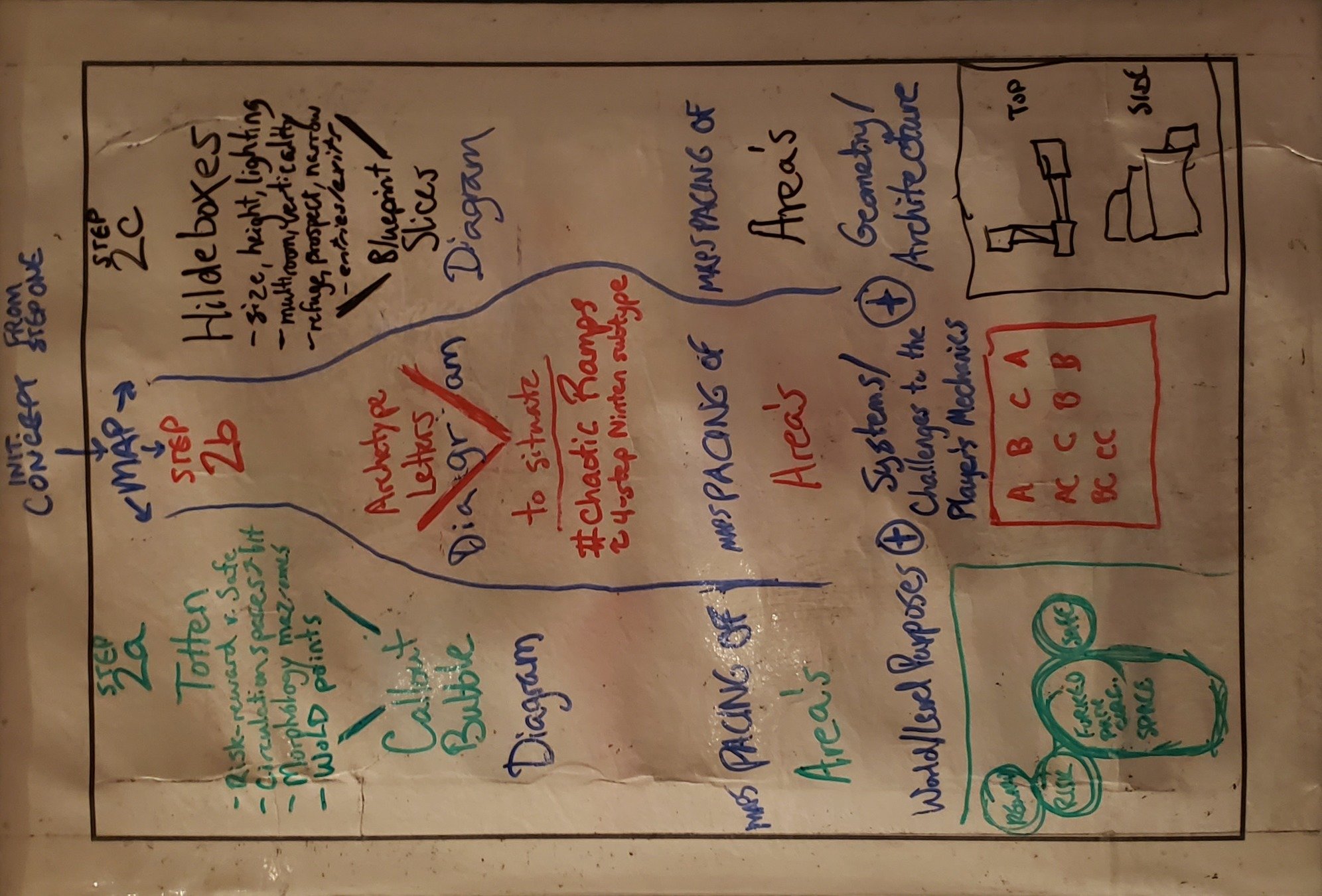Reifying Worlds

Viz the scene's glamour
Play the scene's mood
inspiration: 3D blockouts, image ref, 2D sketches, public concepts, Arch[Viz], phone pics, gameplay/scripting scenarios, your game’s demo level, fave game’s location/level, film clips
to find and execute the LD direction
Pass of Growing DQs
WM Ocarina
+ Slay's South Park pitfall
+ Slay's "WHY" of each character action being the player's primal emotion to accent
2a. Totten
- Risk-reward v. Safe motif
- Circulation spaces b/t ^
- Maze-eme morphology
- WoLD station points


Pacing an area's Purposes, maps their function inside the world and level design
- Each ED = a small story with its start, end, and the decisions between them.
Pass of #chaotic Arrows
QoV
+ Growing sources of conflict, dragons, and decision points
+ Focus on traversing the area in fun, interesting ways
2b. #chaotic
To situate
- #chaotic-stupid Ramps
- 4-step Nintendo subtype
Archetype
Letters
Pacing an area's Systems via Challenges to the player's game mechanics


Add to #chaotic
-
- Brubaker: 9 attack and 9 enemy types to be deep enough
-> "Taking mechanics and strengths that your players would normally use in combat and re-purposing them is not always easy, but the stories you can make from them can be extremely interesting." – e.g. "Players with healing spells may be needed to help ailing villagers. Rangers may be very useful in tracking lost children. Rouges can put their skills to use opening mysterious safes or booby-trapping someone’s vault at their behest."
-
- PvZ's Actually Different Enemy Dimensions
-> Not letting you get away with the same solution all the time.
-> Not using a space (or letting you use it) the same all the time.
-> Synergy b/t the enemies as well as faction-implied motives.
-
- Big sin: repeating a once-imposing enemy x10 later w/no new behaviors.
Add to #chaotic
-
- Picking Enemies: If you’re in a natural location, you can find enemies from that biome that will be a good fit and consider them a starting point. Alternatively, you may have a man-made setting; in that case you’re likely choosing either dungeon monsters or humanoids for your players to fight. Eliminate enemies from the pool that are too exhausting relative to the intended encounter difficulty. Next, start looking at the remaining monsters to consider their fit against your group. I always check to make sure monsters can be defeated by my group. Depending on the group, this might rule out werewolves or ghosts or other monsters with resistances they cannot handle for some reason. Some groups are also too good a fit for some enemies and might line up with monster weaknesses. If that is the case, the best option is to push the CR a little higher and add an additional monster. From here I’ll start considering if I want a homogenous group of monsters or a mixed one. Fighting all one type of monster can be very different from fighting two types of monsters at once. If you are choosing mixed monsters it’s best to consider the roles of the monsters like that of a party. Each should have a part they play. Assuming the monsters are smart enough to work together in the first place they will likely divide up their roles to achieve a core goal.
-
below slides are sub-bullets of this on Encounter Design Notes (Condensed).txt
-
Add to #chaotic
-
- Picking Enemies: <prev slide up>
-
Now, we want to populate the dungeon with creatures. The trick is, we don't want it to feel like the monsters are all standing motionless behind doors, waiting for players to kick in and fight them. We want the dungeon to feel alive, and the easiest way to do that is with factions. Come up with two or three different "Teams" of creatures, and decide how they interact. Take some time to think about how an average day in the dungeon looks, then it's exciting to see how the players are disrupting it. Don’t just stop at how they react to one another, but also how they collectively react to the MC(s) entering upon them.
-
Now, for individual room design. There are four elements to a room that players enjoy- "Puzzles/Traps", "Combat", "Narrative/Lore", and "Reward/Items". If a room has all four of these elements, the player will love the room and always remember it. Three elements, and the players loved the room. Two and they liked it, one and the room sucked, add something else. You can populate most of the Dungeon with "two element" rooms, and vary the elements for pacing. (Like, if one room had combat and a reward, the next room can have lore and a puzzle. Make sure you mix and match, though, so it doesn't get repetitive!)
-
Add to #chaotic
-
- Picking Enemies: <prev slide up>
-
The Dungeon should have two quests- one the players go in knowing about, and one they discover on their own.
-
Control the pacing! Players will want to stop every ten feet to check for traps, analyze every wall for a secret door, etc. Find ways to communicate in and out of character to the players on how you want them navigating the dungeon- a slow pace is fine if that's what you want, but if it's not, make sure you're using narration and DM Fiat to it's fullest extent.
-
Kick their asses. Make it hard, they need to be limping out of the Dungeon holding each other up. I tend to like two hard encounters, 1 deadly encounter, 2 mediums, then some easy encounters sprinkled in. You gotta really work them.
-
https://goblinpunch.blogspot.com/2016/01/dungeon-checklist.html
-
Relative Scaling Pass
SoSpace
+ Angry GM's structure +/-'s
+ The trigger-volume paradigm shift (pull over here from jaquaying column), because trackable rules


2c. Hildeboxes
- Size, height, lighting
- Multi-room, verticality
- Refuge, prospect, narrow
- Entry point(s), exit point(s)
- Previewing sightlines to later encounters
Blueprint
Slices
Pacing an area's Geometry, or Architecture moving over to the environment/level art blockout in the next step 3
- Reminder to stay locked in on the main references!
- Mix distinct ideas with the Shovel Knight mindset
- Find a personal touch to add into the mix after extracting a form, color, etc. in a given reference
- Ask what we haven't seen before, but don't reject an unoriginal idea if you'd wholeheartedly love it = shine! Consider how the ED highlights gameplay strengths uniquely from the stories of all the other EDs! (Keep it feasible by having mechanics rich in possibility space, cf. Brubaker/DPOs. Not just maximizing the player's DPOs, but also those of the enemies!)
- Endings ideally don't just reward #'s, but e.g. new ally, discovered shelter, or secret way into a base, etc.
Pacing Aporias & EE Rewards
-
Beats are AdvanceNext spots that aren't just walking, and/or major encounters.
- Watch out for distances between them: too close/complex or too distant/boring
-
Bubbles affords having 2+ functions, intents, purposes (i.e. bubbles) regardless of walls!
- But pace this complexity: 360-deg of options trips choice paralysis (Fallout: NV!)
- Always consider an object relative to its next largest context: chair/room/house.
- ==================================================================
- Edith: (1) entry/exit points, (2) story interest points, (3) spatial flow b/t 1+2
-
Nintendo Power callouts + "circulation spaces" b/t them for Differences in Kind
- e.g. breathers of movement, obstacles, exploration, puzzles, recharging
- WoLD: note the choke, spawn, player/AI-objective, and cinematic points
-
Hildebrand's alternating spatial sequences
- Narrows (ex. choke points), Refuges, Prospects - Size, Height, Lighting
-
4-step Nintendo pacing => #chaotic-stupid
- Spectrums > Archetypes > Setups > ABCs > Ramps
- Totten's Risk-Reward Junction = uncertainty a player can know the nature of
- Multiroom-verticality > One Boxy Room
- Exploring <=> Figuring Out the Unknown
- Applying the Totten risk reward junction motif to all Hildebrand instantiations
Feedback Check
Closing Doors approach: increasingly narrowed variants around ideas that resonate - not asking "which of these do you like more?" but a specific desired trait, e.g. "which is the scariest?", then after locking that in, "which is the cutest?" etc.
Push them for something to improve upon
(esp. w/professionals savvy in the relevant field)
"you can't get too precious about concepting"
blockouts
Goal: figure out the spatial look & feel overlooked by map, implementing the bubble diagrams.
C
o
m
p
o
s
i
t
i
o
n
s
Jaquaying technique
estab. scene w/symmetry, then imply a story w/asymmetry
Pick one, or for extra focus, narrow the design theme to one variant of that technique premise, ex. multi-level caves as a form of "unusual level connectors." Explore your list in as many ways as possible while designing. Even a 2-room warehouse can have multiple room-connectors and entrances (e.g. skylight, loading dock door, security room door). Just be sure to vary it up vs. being predictably consistent!
-> https://rpgmuseum.fandom.com/wiki/Jaquaying
Making the Block World
- Translate map bubble(s) into an empty block rooms:
- Decide the overall shape of the box's outer "hull"
- Mind how each adj space relates and what that transition's communicating (e.g. stairs) <=> the flow!
- Drop the boxes in - starting at the scene origin.
- Drop in a character mannequin model and spawn, ensure it can jump & run along rooms (i.e. correct scale metrics).
- Once you have 1 room you know nails your spatial L&F, you can then use it to compare/cut if others live up to it.
Goal: making the space itself before picking and placing things into it, i.e. ask how player flow connects w/beats. -- Does the hull work against what it and adjacent spaces need to accomplish?
- Be ever willing to cut, whether just blockworld, or also walkthrough, or also concept! (Like KNKL variants!)
- Using player visual cues if invoking an area's verticality
- Consider mapping the rising "spatial mastery" via GMTK Boss Keys videos? Even outside dungeons? Even 2.5D?
- Trigger-volume paradigm: Write up any major events that can happen in your encounter, e.g. "breakable dam," with what activates it and what happens when activated. Consider at least what causes a change in the ED.
- After you get to a very rough draft, move to next step
Feedback Check
Closing Doors approach: increasingly narrowed variants around ideas that resonate - not asking "which of these do you like more?" but a specific desired trait, e.g. "which is the scariest?", then after locking that in, "which is the cutest?" etc.
Push them for something to improve upon
(esp. w/professionals savvy in the relevant field)
"you can't get too precious about concepting"
Reifying Worlds - The Level Design
By twila
Reifying Worlds - The Level Design
- 248



